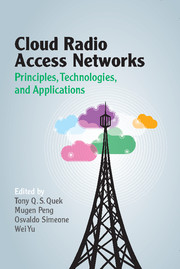Book contents
- Frontmatter
- Contents
- Acknowledgments
- Foreword
- Preface
- List of Contributors
- Part I Architecture of C-RANs
- Part II Physical-Layer Design in C-RANs
- Part III Resource Allocation and Networking in C-RANs
- 10 Resource Management of Heterogeneous C-RANs
- 11 Coordinated Scheduling in C-RANs
- 12 Delay-Aware Radio Resource Allocation Optimization in Heterogeneous C-RANs
- 13 C-RAN Using Wireless Fronthaul: Fast Admission Control and Large System Analysis
- 14 Toward Green Deployment and Operation for C-RANs
- 15 Optimal Repeated Spectrum Sharing by Delay-Sensitive Users
- Part IV Networking in C-RANs
- Index
- References
13 - C-RAN Using Wireless Fronthaul: Fast Admission Control and Large System Analysis
from Part III - Resource Allocation and Networking in C-RANs
Published online by Cambridge University Press: 23 February 2017
- Frontmatter
- Contents
- Acknowledgments
- Foreword
- Preface
- List of Contributors
- Part I Architecture of C-RANs
- Part II Physical-Layer Design in C-RANs
- Part III Resource Allocation and Networking in C-RANs
- 10 Resource Management of Heterogeneous C-RANs
- 11 Coordinated Scheduling in C-RANs
- 12 Delay-Aware Radio Resource Allocation Optimization in Heterogeneous C-RANs
- 13 C-RAN Using Wireless Fronthaul: Fast Admission Control and Large System Analysis
- 14 Toward Green Deployment and Operation for C-RANs
- 15 Optimal Repeated Spectrum Sharing by Delay-Sensitive Users
- Part IV Networking in C-RANs
- Index
- References
Summary
Introduction
The fifth generation (5G) mobile communication systems are expected to provide ultrahigh data rate services and seamless user experiences across the whole network [1, 2]. The 5G system capacity is expected to be 1000 times greater than current fourth generation (4G) mobile systems. In order to meet such demanding requirements, as well as to reduce the capital investment and operational cost, C-RAN has been proposed as a promising network architecture for future mobile communication systems. In C-RAN, most signal processing functions are performed at the centralized baseband unit (BBU) pool, while data transmission to the users is provided by remote radio heads (RRHs), which are usually low-power nodes serving local area users. It is known that the hyper-dense deployment of RRHs will be a key factor in serving large numbers of users and achieving tremendous capacity enhancement in future mobile systems [3]. The transportation of user data and control signals between the BBU pool and the RRHs is carried out in the fronthaul [4].
The fronthaul is a major constraint for the practical implementation of C-RANs. In order to provide high quality-of-experience services to users in the network, fast and reliable fronthaul connections between the BBU pool and the RRHs must be established [5, 6].Wired fronthaul, using optical fiber cables, can provide high-rate data links between fixed stations. However, the cost of providing wired fronthaul to all RRHs may be prohibitive when the number of RRHs is large. Moreover, certain locations that are difficult to reach by wired access may restrict the universal deployment of wired fronthaul. Wireless fronthaul, which can overcome many drawbacks of wired fronthaul, offers a cost-effective alternative [7-9]. Compared with wired fronthaul, the management of wireless fronthaul resources, e.g., their power and spectrum, is more complicated owing to finite power and radio spectrum constraints.
Recent works have proposed analysis and design methods for fronthaul and backhaul technologies from many aspects. A linear programming framework for determining the optimum routing and scheduling of data flows in wireless mesh backhaul networks was proposed in [10]. Zhao et al. [11] considered the problem of minimizing backhaul user data transfer in multi-cell joint processing networks, where algorithms involving the joint design of transmit beamformers and user data allocation at base stations (BSs) were proposed to effectively reduce backhaul user data transfer.
Information
- Type
- Chapter
- Information
- Cloud Radio Access NetworksPrinciples, Technologies, and Applications, pp. 314 - 346Publisher: Cambridge University PressPrint publication year: 2017
